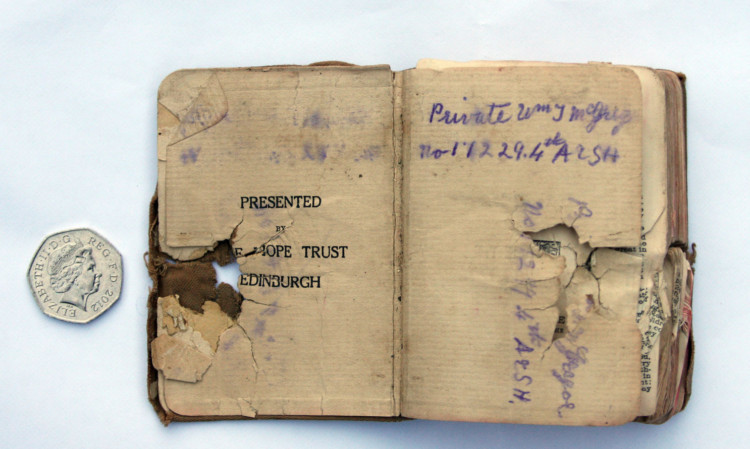
A tragic soldier’s bloodstained Bible has been brought back to Britain after almost 90 years.
The small copy of the New Testament was one of just a handful of items carried by Private William James McGregor as he fought during the First World War. It has travelled more than 22,000 miles through battlefields and across several seas and oceans on its grief-ridden journey.
Now a distant relative who inherited the heirloom has embarked on a desperate search for a closer member of the soldier’s family to take care of it.
Unlike some soldiers whose lives were saved by their Bibles, William was killed when an enemy bullet burst through every page and punctured his heart. He was with the 2nd Battalion 4th Argyll & Sutherland Highlanders and was killed at the Somme on February 28, 1917. He was buried in a communal grave in France but, in an unusual twist, the army sent the gruesome Bible back to his family in Glasgow.
William’s sister Margaret took it with her when she emigrated to Australia in 1926 before passing it to her daughter, Heather Dobson. Aged 83, Heather kept it for more than 70 years but has now given the Bible to nephew Frank Dobson who brought it back to Britain in the hope of tracing other family members or a museum to care for it.
Frank, 70, from Wigan, said: “Heather asked me to find relatives from William’s family in Scotland who might want it.
“I feel a tremendous responsibility. It has to go to someone who will appreciate it. Otherwise I’ll give it to The Argyll & Sutherland Highlanders Museum at Stirling Castle.
“The bullet hole goes right through the Bible. You can see a red hue on the end of pages where it soaked up his blood. Future generations should be able to see it and recognise the sacrifice William made.”
Soldiers often carried Bibles in the top right pocket of their tunics. On a number of occasions they are known to have saved lives by halting a bullet or piece of shrapnel.
William’s story is in contrast to fellow Scot Private George Mackie from Aberdeen. He was also fighting at the Somme that year with the Gordon Highlanders, but was saved when a bullet hit his Bible and stopped.
Rod MacKenzie, deputy curator of the Argyll & Sutherland Highlanders Museum said: “It’s surprising that the army sent the Bible back because it was bloodstained.
“It must have been quite a shock. They obviously thought it was such a personal item that the family would want to have it. I’ve never seen a bloodstained Bible before.”
Heather was never in contact with her mum’s family in Scotland. However, she knows William’s parents were called Alexander and Mary, whose maiden name was Thompson.
He also had another sister, Patricia, and three brothers who were killed in the War. The family are thought to have owned a dairy on Sauchiehall Street in Glasgow in the 1900s.
Do you know someone from William’s family? If so, get in touch on 0141 567 2722.

Enjoy the convenience of having The Sunday Post delivered as a digital ePaper straight to your smartphone, tablet or computer.
Subscribe for only £5.49 a month and enjoy all the benefits of the printed paper as a digital replica.
Subscribe